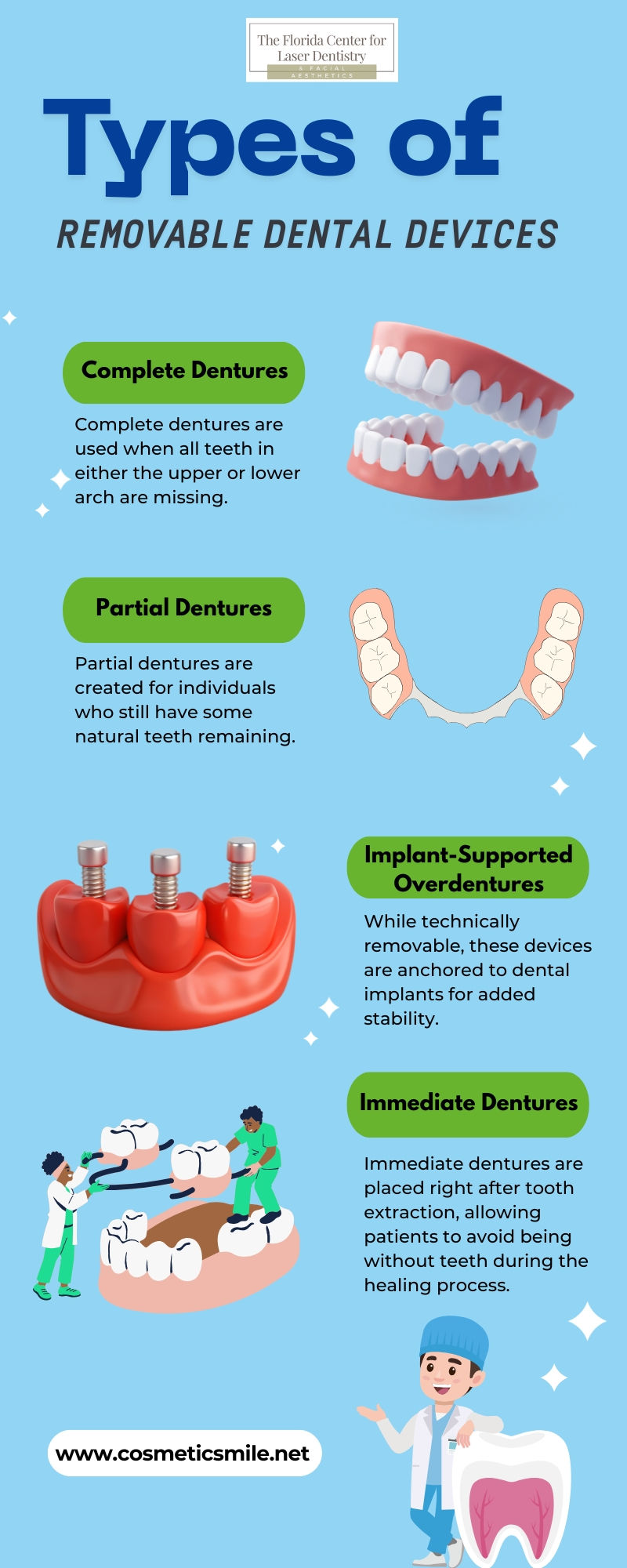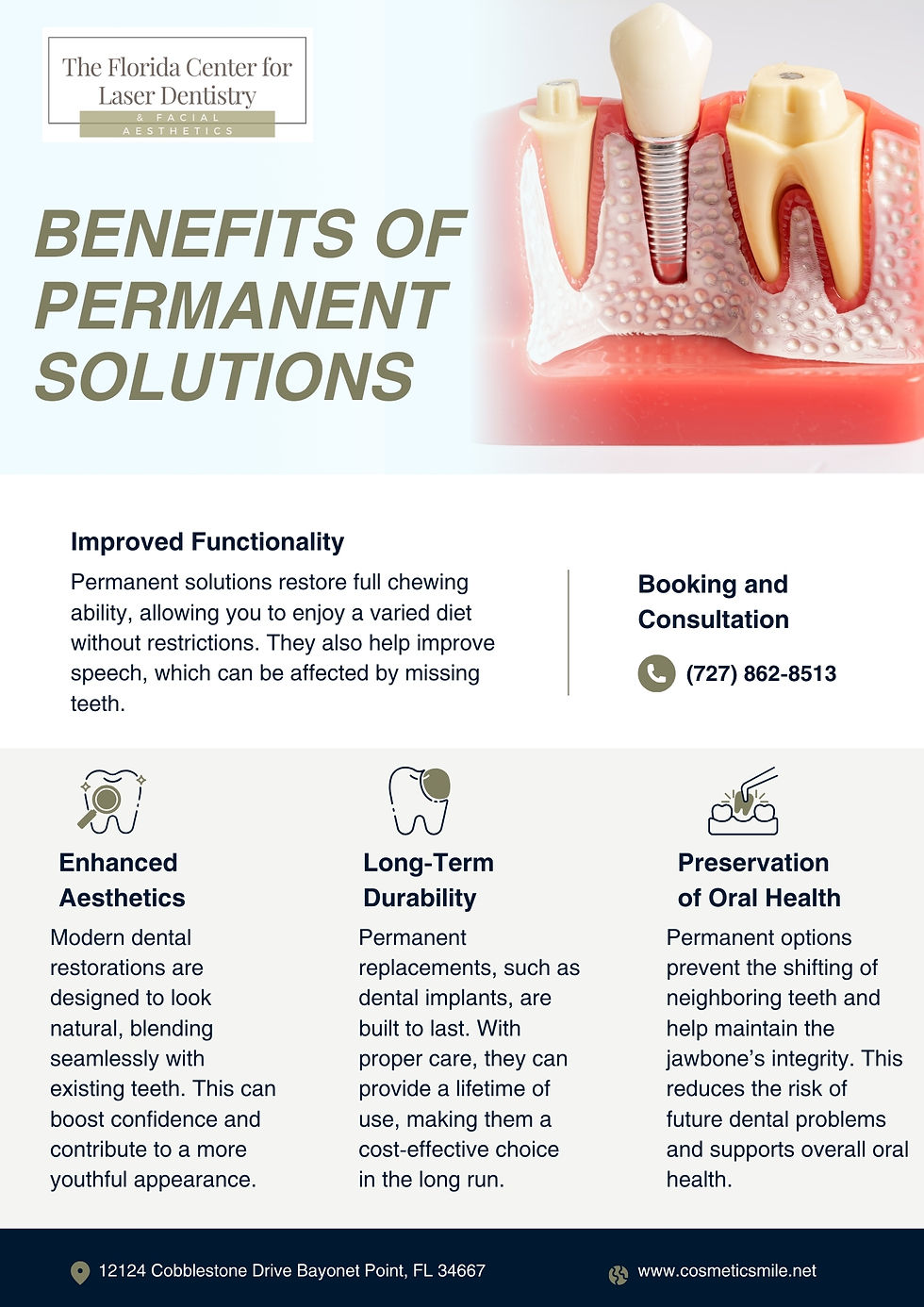The Benefits and Advances in Removable Prosthetics
- Cosmetic Smile
- Sep 17, 2025
- 5 min read
Tooth loss is a common challenge faced by people of all ages, whether due to injury, decay, or other health-related issues. Modern dentistry has provided many solutions to restore function, comfort, and aesthetics, and among them, removable prosthetics have remained a trusted option for decades. These dental devices are designed to replace missing teeth while giving patients the ability to speak, chew, and smile with confidence. Over the years, they have evolved with advanced materials, improved designs, and enhanced comfort, making them more effective and lifelike than ever before.
This article explores the different types, benefits, care practices, and recent innovations in removable dental devices, helping patients understand why they continue to be a vital solution for restoring oral health.
What Are Removable Prosthetics?
At their core, removable prosthetics are dental appliances designed to replace missing teeth and surrounding tissues. Unlike fixed solutions such as implants or bridges, these devices can be taken out of the mouth for cleaning, adjustments, or comfort. They are often used when multiple teeth are missing or when a patient prefers a less invasive and more cost-effective option compared to surgical procedures.
The main goal of these devices is to restore oral functions like chewing and speaking while also improving the appearance of a person’s smile. They can be partial, replacing a few missing teeth, or complete, replacing an entire arch of teeth in the upper or lower jaw.
Types of Removable Dental Devices
There are several categories of removable appliances, each suited for different dental needs:

1. Complete Dentures
Complete dentures are used when all teeth in either the upper or lower arch are missing. Modern versions are designed with high-quality acrylics and flexible materials that improve comfort and provide a natural look. They restore the patient’s ability to chew and speak properly, while also supporting facial muscles to prevent a sunken appearance.
2. Partial Dentures
Partial dentures are created for individuals who still have some natural teeth remaining. They fill the gaps caused by missing teeth while preventing the remaining ones from shifting out of position. Metal or flexible frameworks often provide support and stability, ensuring the device stays in place during daily activities.
3. Implant-Supported Overdentures
While technically removable, these devices are anchored to dental implants for added stability. They combine the benefits of traditional dentures with the strength of implants, making them less likely to slip or cause discomfort. Overdentures are particularly beneficial for patients with bone loss, as implants help preserve jawbone density.
4. Immediate Dentures
Immediate dentures are placed right after tooth extraction, allowing patients to avoid being without teeth during the healing process. They are later adjusted or replaced once the gums and bone have healed fully.
Advantages of Removable Dental Devices
These dental solutions remain a popular choice for several reasons:
Affordability: Compared to permanent options like implants, they are more cost-effective, making them accessible to a wider range of patients.
Non-Invasive: Unlike surgical solutions, they do not require complex procedures, making them suitable for patients with medical conditions or those who wish to avoid surgery.
Adaptability: They can be adjusted, relined, or replaced over time to accommodate changes in the mouth, such as bone resorption.
Restoration of Function: They help restore chewing efficiency and proper speech patterns, both of which are often compromised by missing teeth.
Aesthetic Improvement: Designed to mimic natural teeth, they enhance a person’s appearance and restore self-confidence.
Challenges and How They Are Overcome
While removable appliances provide many benefits, patients sometimes express concerns about stability, comfort, and maintenance. Fortunately, modern dentistry has introduced solutions to address these challenges:
Improved Fit: Advanced impression techniques ensure a closer and more comfortable fit, reducing slipping and irritation.
Better Materials: Lightweight and flexible materials now offer greater comfort compared to traditional rigid designs.
Enhanced Retention: Options like implant-supported overdentures provide extra stability for patients seeking more security.
Natural Appearance: High-quality acrylics and ceramic options are shaded to match natural gums and teeth, improving aesthetics.
Proper Care and Maintenance
To ensure the longevity and comfort of removable dental devices, proper care is essential:
Daily Cleaning: Clean the device with a soft brush and non-abrasive cleanser to remove food particles and plaque. Avoid using regular toothpaste, as it may cause scratches.
Soaking Overnight: Most appliances should be soaked in a denture-cleaning solution overnight to maintain shape and hygiene.
Oral Hygiene: Even with artificial replacements, gum health is crucial. Patients should continue brushing gums, tongue, and any remaining teeth.
Regular Check-Ups: Dental visits are important for ensuring proper fit, checking for wear, and making necessary adjustments.
Handling With Care: Dropping them may cause cracks or breakage, so it is recommended to clean them over a folded towel or basin of water.
Lifestyle Benefits
Patients who use removable dental solutions often report significant improvements in their daily lives:
Enhanced Confidence: Smiling, speaking, and eating in public become less stressful, boosting self-esteem.
Dietary Freedom: While certain hard or sticky foods should be avoided, most patients regain the ability to enjoy a wider variety of meals.
Social Engagement: Improved speech and appearance encourage patients to interact more freely in social and professional settings.
Better Health: Replacing missing teeth supports overall oral health, reducing strain on remaining teeth and minimizing long-term complications.
Innovations in Removable Dental Devices
Advances in technology have brought significant improvements:
Digital Dentistry: Digital impressions and 3D printing are revolutionizing how dentures are designed, offering more precise fits and faster turnaround times.
Flexible Materials: New polymers provide lightweight, durable, and comfortable alternatives to traditional rigid bases.
Biofunctional Designs: These innovations ensure that prosthetic devices work harmoniously with natural oral movements, reducing discomfort.
Customization: Modern solutions allow for individualized shading, tooth alignment, and gum tinting to provide a more natural appearance.
Who Should Consider Removable Dental Solutions?
These dental devices are suitable for a wide range of patients:
Individuals who have lost several or all of their teeth.
Patients looking for a cost-effective alternative to implants.
People with medical conditions preventing surgical treatments.
Those who want a non-permanent solution that can be easily adjusted over time.
Before choosing the right option, a thorough evaluation by a dental professional is essential to consider oral health, bone density, and lifestyle preferences.
The Future of Removable Dentistry
With continuous innovation, removable dental solutions are expected to become even more effective, comfortable, and lifelike. Digital scanning, artificial intelligence, and biocompatible materials are paving the way for a new era in dental prosthetics, where the line between natural and artificial teeth becomes increasingly blurred.
Tooth loss does not have to mean a loss of confidence or quality of life. Modern removable prosthetics provide patients with reliable, affordable, and natural-looking solutions that restore both function and aesthetics. With proper care, these devices can significantly improve daily comfort and oral health while offering a flexible approach for those who prefer a non-invasive option.
For patients seeking expert guidance and personalized treatment, The Florida Center for Laser Dentistry offers professional care to help restore smiles with advanced dental solutions.



Comments